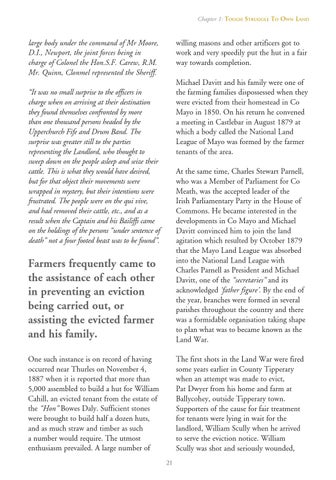Chapter 1: TOUGH STRUGGLE TO OWN LAND
large body under the command of Mr Moore, D.I., Newport, the joint forces being in charge of Colonel the Hon.S.F. Carew, R.M. Mr. Quinn, Clonmel represented the Sheriff.
willing masons and other artificers got to work and very speedily put the hut in a fair way towards completion. Michael Davitt and his family were one of the farming families dispossessed when they were evicted from their homestead in Co Mayo in 1850. On his return he convened a meeting in Castlebar in August 1879 at which a body called the National Land League of Mayo was formed by the farmer tenants of the area.
“It was no small surprise to the officers in charge when on arriving at their destination they found themselves confronted by more than one thousand persons headed by the Upperchurch Fife and Drum Band. The surprise was greater still to the parties representing the Landlord, who thought to sweep down on the people asleep and seize their cattle. This is what they would have desired, but for that object their movements were wrapped in mystery, but their intentions were frustrated. The people were on the qui vive, and had removed their cattle, etc., and as a result when the Captain and his Bailiffs came on the holdings of the persons “under sentence of death” not a four footed beast was to be found”.
Farmers frequently came to the assistance of each other in preventing an eviction being carried out, or assisting the evicted farmer and his family.
At the same time, Charles Stewart Parnell, who was a Member of Parliament for Co Meath, was the accepted leader of the Irish Parliamentary Party in the House of Commons. He became interested in the developments in Co Mayo and Michael Davitt convinced him to join the land agitation which resulted by October 1879 that the Mayo Land League was absorbed into the National Land League with Charles Parnell as President and Michael Davitt, one of the “secretaries” and its acknowledged ‘father figure’. By the end of the year, branches were formed in several parishes throughout the country and there was a formidable organisation taking shape to plan what was to became known as the Land War.
One such instance is on record of having occurred near Thurles on November 4, 1887 when it is reported that more than 5,000 assembled to build a hut for William Cahill, an evicted tenant from the estate of the “Hon” Bowes Daly. Sufficient stones were brought to build half a dozen huts, and as much straw and timber as such a number would require. The utmost enthusiasm prevailed. A large number of
The first shots in the Land War were fired some years earlier in County Tipperary when an attempt was made to evict, Pat Dwyer from his home and farm at Ballycohey, outside Tipperary town. Supporters of the cause for fair treatment for tenants were lying in wait for the landlord, William Scully when he arrived to serve the eviction notice. William Scully was shot and seriously wounded, 21
